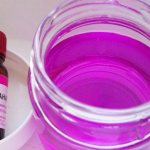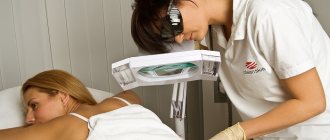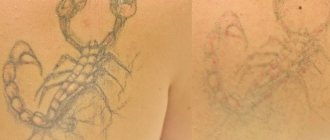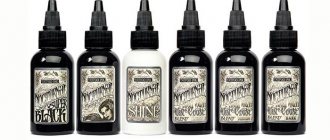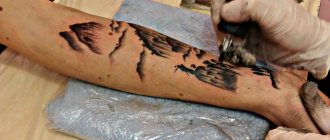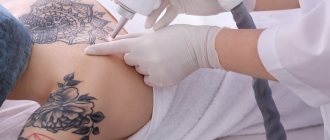Not always tattoos are the result of a carefully considered and weighted decision. In a rush of feelings it is easy to go to the first beauty salon and to strike a sweetheart's name or picture that came to mind. And only then, when rationality takes over again, begins to think about how to remove a tattoo that was done on emotion.
It is possible to wish to get rid of the figure on the body for different reasons, everyone has his own. However, before going to the salon, it is worth finding out more information about the very process of tattoo removal.
Bath .
It is believed that if you have a bad tattoo, a trip to the bath and increased sweating will save and the tattoo will disappear. The logic is simple: if the master forbids the bath immediately after the procedure, then, acting on the contrary, you can get rid of the pattern.
Bathing is prohibited primarily because heat procedures stimulate lymph outflow and increase blood circulation. The tattoo will remain, but the pronounced swelling of the tissues, which will disrupt the vital activity of the skin cells, can hold up to a month.
Tatiana Kleiman
What can influence the success of the result
Many materials on how to remove tattoos at home show only photos before and after successful removal. But in reality, things may not go as originally planned.
There are several standard parameters that affect the success of the result:
- Type of pigment. Some dyes dissolve more easily, while others are more persistent. You can never tell in advance exactly what you'll end up with.
- Saturation. It is most difficult to remove saturated dark tattoos.
- The timing of the drawing. Many old images turn out to be not so easy to remove.
- Willingness to properly perform the procedure and endure pain. Home removal is always painful, extremely uncomfortable and dangerous. It is worth being prepared for the fact that some methods of removal will take several months.
At the same time, even after months of effort and suffering, no one will give guarantees that the drawing will actually be able to be removed.

Remover
Remover is a special lightening fluid, which is used as in the correction of microblading and tattooing, as well as for the removal of artistic tattoos. First it is introduced, as well as the pigment, under the skin, and then this place is treated with a certain compound to fix the action.
Now there are many proposals on the market removers, some are good for the removal of organic pigments, others for non-organic, and others work with both. This method is undoubtedly effective. However, you need to follow the recommendations and apply remuver at home for a long time.
Tatiana Kleiman
Probable Consequences
We highly recommend not even googling queries about how you can remove a tattoo at home. You may well come across shock content or recommendations from people who have never had anything removed themselves.
There are several potential problems:
- The drawing simply won't come out. The lesser of the evils is that the tattoo will remain on the skin.
- The tattoo will turn into an ugly stain. It will blur and be much harder to fight.
- A burn will appear on the spot. The skin needs to be treated properly, because part of the dermis layer is simply burned out with all the likely consequences.
- Infection. Even with proper care, there is always a chance that suppuration will show up. There is also a high risk of blood infection. This process can lead to surgery, amputation.
It is worth remembering that the process itself is extremely painful. It puts a great deal of pressure on the psyche, because a person is forced to self-mutilate for a long time. Not everyone can stand it.


Cauterize with manganese.


In the old days there was a popular method of reducing tattoos with concentrated manganese. Serious burns will be left on the body. Not only the skin will be damaged, but also veins, vessels, and internal tissues. Treatment will have to be very long, expensive and not always successful. It could end up as an amputation, or even worse. An ugly scar in any case is guaranteed.
Video material
Therefore, you should not be surprised if your neighbor reduced the tattoo with vinegar essence in a few days, and you have even after the second cycle of these painful procedures, the result is very modest. It is necessary to remember also that, having begun to reduce a tattoo by one method, do not pass on to another. It is necessary to treat very carefully also to concentration of preparations and time of their influence. And do not forget - all surgical operations should be done only with clean hands. And even better - do not experiment with your health, and consult a specialist!
Use proven and safe methods
And here a reasonable question arises - why in general so to suffer and risk? All methods of removal at home are as artisanal as possible. Technology has stepped forward.
Today you can come to the studio and in just a few sessions completely remove the tattoo. For example, a laser is actively used. It works pinpoint and effectively. You will watch as the tattoo gradually becomes lighter and lighter, and eventually completely disappears from your body.
With laser and other methods of professional removal, you will get a noticeable, quality effect. The health risks will be minimal and the recovery period will not take long. There is no risk of infection, suppuration, large burns and ugly scars.
We recommend not using home methods under any circumstances. They pose a real danger and can lead to serious negative consequences for the body. Modern professional tattoo removal is affordable and performed according to proven techniques.
Share this link:
What are the dangers of a tattoo
- First of all, this "decoration" is not eternal. Over time, the design will lose its original shape. It is probably not worth mentioning how unattractive tattoos look on aging, flabby skin.
- When applying a tattoo it is possible to get an infection, and we are talking not only about inflammatory processes, but also about such diseases as AIDS.
- When using low-quality dyes containing, for example, lead, which is not uncommon, skin cancer can develop.
Before you get a tattoo, you should think carefully and compare the pros and cons.


Tattooing
How do they remove tattoos in salons?
In a cosmetic salon, the master can offer several ways to remove tattooing. Each of them has both advantages and disadvantages.
Camouflage method
In place of the old picture, a new one is applied, using a masking pigment. In fact, this is the same tattoo, only in the tone of the skin.
Among the advantages we can only highlight the fact that in this way it is possible to correct a small omission in the tattoo, to remove the camouflage pattern is not recommended. Of the disadvantages stand out:
- Camouflage is not adapted to tanning. When skin tone changes, the masking "spot" will stand out.
- It is not possible to cover a large pattern with this method.
- If the color of the tattoo is saturated, the old pigment may show through the camouflage layer.
- The old pigment mixes with the new pigment.
- The flesh-colored pigment will eventually begin to change its coloring.
Overlaying with a new tattoo
A simple solution if the old tattoo is bored, but there is no desire to permanently remove the design. In order for the new tattoo to lie on the skin without problems, the old pigment can be specially removed, according to the recommendations of the master. In this way it will not be possible to make the new design light to completely overlap the old picture or inscription.
Skin excision
Before the introduction of lasers, excision was the only way to remove unwanted artwork. The tattoo would go away in one session, but leave behind unpleasant scars.
The essence of the method is that the surgeon removes part of the skin and shrinks the rest. It can take a long time to recover.
Chemical peels
It is made with phenol, which is why it is not popular: this acid is dangerous to health. In addition, chemical peels are extremely painful and are performed under anesthesia.
After the procedure, there is a long period of rehabilitation, and sometimes the consequences of the use of chemistry manifest themselves years later. Nevertheless, the method has several advantages:
- The procedure costs significantly less than others.
- Small patterns with superficial pigment deposits are very easy to remove.
- No problem removes any color of the pattern.
Cryosurgery
Liquid nitrogen is used to remove tattoos. A cloth soaked in it is placed against the body to form an icy crust. After about two hours, the affected area swells up, sometimes bubbling over with liquid. On the third day after the procedure, a dry crust remains on the skin, which eventually falls off.
Disadvantages of the cryogenic method:
- Takes a long time.
- Painful.
- Takes a long time to recover.
- Impulsive people can get sick at the sight of the consequences of the procedure.
- Tattoo removal leaves scars, which disappear over time.
Electrocoagulation
Tattoos are cauterized with a high-frequency current through electrodes. The procedure is performed exclusively under local anaesthesia. If the specialist who carries out the procedure is not qualified, burns may remain.
After electrocoagulation, a crust will form on the affected area, falling off after a week. You will eventually be left with a scar. It is possible to reduce tissue scarring by following the instructions of the cosmetologist and using healing ointments after the procedure.
Dermabrasion
A simpler name for the procedure is skin resurfacing. It is performed with the help of a diamond cutter.
The essence of the method is to remove layers of skin with pigment. Out of the disadvantages are highlighted:
- For a complete tattoo removal may require up to three sessions.
- After dermabrasion, there is a long period of rehabilitation.
- The procedure significantly reduces the protective function of the dermis, which increases the likelihood of infection.
- After dermabrasion, the skin must be properly cared for with disinfecting ointments and dressings.
- Dermabrasion leaves scars that are not easy to get rid of.
- The procedure is not good at removing deep-seated pigment. It is also not used to remove large tattoos.
The procedure requires a cosmetologist with extensive experience and high qualifications.
Laser method of removal
The laser is considered the most advanced way to get rid of a tattoo. It has a pinpoint effect and burns the pigment, minimally affecting the skin. Clean tissue is not affected.
Salons use different types of lasers for tattoo removal:
- Ruby. It brings out the green color, but does not handle deeply embedded pigment and red elements of drawings well. Works slowly, so the session may last longer than usual.
- Alexandrite. For him tattoo removal -signature is an easy task. Works well with surface pigment. Faster than ruby, but also does not cope with red and pink shades.
- Diode. Copes with shades that the Alexandrite and Ruby don't pick up. After using the Diode laser, no more hair grows in the areas where it has gone through because it damages the hair follicle.
- Neodymium. A universal laser of the latest generation. Copes with both dark and bright colors, burns them out of the deep layers of the dermis without any problems. It doesn't cause tissue scarring.
The laser beam is able to penetrate deep under the skin. This is relevant if the tattoo mater was not experienced, and the pigment is deposited on the deep layers of the dermis.
The procedure does not cause much pain, but local anesthesia is used if necessary.
The laser has only three disadvantages:
- Laser tattoo removal Requires several sessions to remove the design, but one procedure does not last long. Ten minutes is usually enough to treat a small, palm-sized area.
- Blisters may form after the laser. They go away within a month.
- Expensive procedure.
Laser vaporization
Otherwise known as ablative Tattoo removal. The method consists of vaporizing the pattern with a laser beam.
The method is only suitable for the removal of professionally made tattoos with shallow pigment. If the ink is below the epidermis, some of the pattern may remain after the procedure. Moreover, vaporization can seriously damage the skin.
Use of Removers
Remuver is a liquid specially created to correct tattooing. It also does a good job of removal of tattoos.
The remover is injected under the skin, which is then treated with an additional compound. This allows you to fix the discoloration of the pigment.
When using this method, it is worth paying attention to the selection of removers. Some of them remove only organic pigments, while others do not take them at all. Those removers that have the same effect on pigment from all components cost more.
The procedure is performed exclusively in salons, in order to protect the removing tattoo from infection.
Cooking salt


Take two spoons of salt, pour a very small amount of water, stir until a supersaturated solution is formed. Soak a clean sponge in this solution and rub the drawing with it in circular motions for half an hour. Then rinse the skin area with water and apply a bandage to protect it from infection. And so every day for months until the image disappears. The hope here is that the salt will draw in some of the paint from day to day. Don't despair, you will have to do this for more than a month. The result is not guaranteed. It may fade over time, but it is unlikely to disappear altogether. The skin in this place will become coarser and change color.
Cut it off along with the skin.


Very painful and not always effective: it all depends on how the tattoo is applied. Good for very small drawings. And dangerous: doing it yourself or with the help of a friend, you can get a deep, nonhealing wound. If you go to a surgeon, it's again money, and not every doctor will agree to such an operation. Even if the operation goes relatively well, you will have an ugly scar for life. It is unlikely it will be more beautiful than the removed tattoo.
Grinding with a nylon brush


Grinding is performed with nylon brushes. First the epidermis is removed, the pigment protrudes more brightly. Then the underlying layers are removed until completely removed. Creepy!
In the Internet you can find quite a few different ways from the morons who say that the tattoo can be reduced in the bath, with a carrot grater and so on. The reader should understand: all this is complete nonsense and obscurantism.
